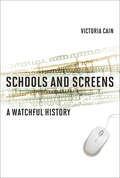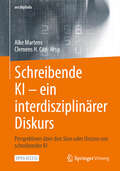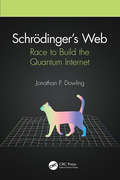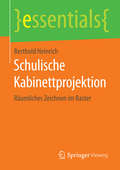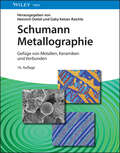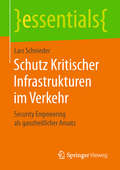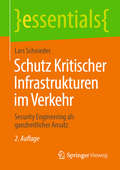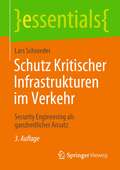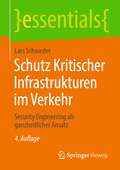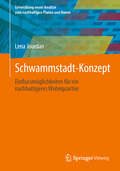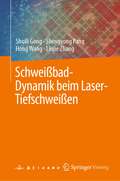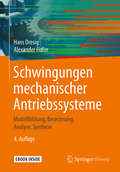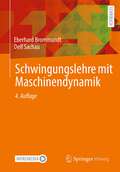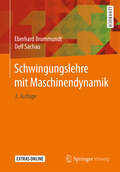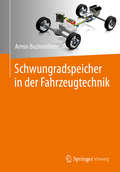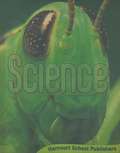- Table View
- List View
Schools and Screens: A Watchful History
by Victoria CainWhy screens in schools—from film screenings to instructional television to personal computers—did not bring about the educational revolution promised by reformers.Long before Chromebook giveaways and remote learning, screen media technologies were enthusiastically promoted by American education reformers. Again and again, as schools deployed film screenings, television programs, and computer games, screen-based learning was touted as a cure for all educational ills. But the transformation promised by advocates for screens in schools never happened. In this book, Victoria Cain chronicles important episodes in the history of educational technology, as reformers, technocrats, public television producers, and computer scientists tried to harness the power of screen-based media to shape successive generations of students. Cain describes how, beginning in the 1930s, champions of educational technology saw screens in schools as essential tools for training citizens, and presented films to that end. (Among the films screened for educational purposes was the notoriously racist Birth of a Nation.) In the 1950s and 1960s, both technocrats and leftist educators turned to screens to prepare young Americans for Cold War citizenship, and from the 1970s through the 1990s, as commercial television and personal computers arrived in classrooms, screens in schools represented an increasingly privatized vision of schooling and civic engagement. Cain argues that the story of screens in schools is not simply about efforts to develop the right technological tools; rather, it reflects ongoing tensions over citizenship, racial politics, private funding, and distrust of teachers. Ultimately, she shows that the technologies that reformers had envisioned as improving education and training students in civic participation in fact deepened educational inequities.
Schreibende KI -- ein interdisziplinärer Diskurs: Perspektiven über den Sinn oder Unsinn von schreibender KI (ars digitalis)
by Clemens H. Cap Alke MartensDer Einsatz von Künstlicher Intelligenz als Ersatz menschlich kreativer Leistungen ist ein intensiv diskutiertes Feld. Aus Sicht der Informatik verbergen sich in den zugrunde liegenden Softwarekonstrukten Modellvorstellungen und auch Fehlannahmen über die Funktion des menschlichen Denkens. Die Beiträge in diesem Buch stammen von Expertinnen und Experten verschiedener Disziplinen— z.B. Informatik, Ethik, Jura und Medizin. Dies ist ein Open-Access-Buch.
Schrödinger’s Web: Race to Build the Quantum Internet
by Jonathan P. DowlingAs the race to build the world&’s first quantum computer is coming to an end, the race to build the quantum internet has just started. This book leverages the author&’s unique insights into both the Chinese and American quantum programs. It begins with the physics and history of the quantum internet and ends with the latest results in quantum computing and quantum networks. The Chinese quantum Sputnik moment. The U.S. National Quantum Initiative. What&’s up with Quantum Computing Supremacy? The Race to Build the Quantum Internet. Where will Quantum Technology be Tomorrow? Written by a renowned quantum physicist, this book is for everyone who is interested in the rapidly advancing field of Quantum Technology — The Second Quantum Revolution. The 2016 launch of the Chinese quantum satellite Mozi was a quantum Sputnik moment. The United States went from thinking it was ten years ahead of the Chinese to the realization that it was ten years behind them. This quantum gap led to the U.S. National Quantum Initiative, launched in 2018. Since then, the race to build the quantum internet has taken off at breakneck speed.
Schulische Kabinettprojektion: Räumliches Zeichnen im Raster (essentials)
by Berthold HeinrichBerthold Heinrich stellt die mathematischen und zeichnerischen Grundlagen für die Darstellung von Objekten im Raum auf kariertem Papier vor. Dabei präsentiert er auch die Nutzung von Software. In der Schule wird oft kariertes Papier als Raster zur Darstellung von Flächen und Körpern genutzt. Allerdings werden, selbst in einigen Druckwerken, z. B. die entstehenden Ellipsen und Winkelbögen ungenau gezeichnet oder eine Kugelkontur falsch als Kreis dargestellt. Im vorliegenden Essential werden die korrekten Verfahren sowohl theoretisch als auch an konkreten Beispielen vorgestellt und können meist direkt umgesetzt werden. Einige aufwändigere Abläufe stellt der Autor anschaulich an Beispielen dar.
Schumann Metallographie
by Heinrich Oettel Gaby Ketzer-RaichleDas Standardwerk der Metallographie in der vollständig überarbeiteten und ergänzten 16. Auflage Die Metallographie gehört zu den klassischen Bereichen der Werkstoffwissenschaft. Man versteht darunter die Untersuchung von metallischen Werkstoffen mit verschiedenen, meist bildgebenden mikroskopischen Verfahren, um Informationen über die Struktur und vor allem das Gefüge der Werkstoffe zu erlangen. Gefüge und Mikrostruktur einschließlich der chemischen Zusammensetzung eines Werkstoffes geben Aufschlüsse über seine Entstehung und Verarbeitung, die Eigenschaften und Qualitätsparameter, aber auch über aufgetretene Fehler und Schädigungen des geprüften Werkstückes. Heinrich Oettel (Freiberg) und Gaby Ketzer-Raichle (Aalen) haben an der bewährten Gliederung des „Schumann“ festgehalten: Strukturelle Grundlagen – optische und elektronenoptische Mikroskopie einschließlich Beugungsverfahren – Phasengleichgewichte / Zustandsdiagramme / Phasenumwandlungen – Technische Gefügebildung – Gefüge von wichtigen insbesondere metallischen Werkstoffgruppen. Praxisnah führt das Buch in die relevanten Grundlagen der Metallographie ein und stellt die Präparations-und Untersuchungsverfahren vor, die für die tägliche Arbeit benötigt werden. Zum Verständnis und zur Interpretation der vielfältigen Gefügeausbildungen gibt das Buch einen umfassenden Überblick über Phasengleichgewichte und Zustandsdiagramme, bevor ausführlich der Einfluss von Verarbeitung und Behandlung auf verschiedene Materialsysteme diskutiert wird. Bewährtes Konzept und stark überarbeitete Inhalte: Methoden, Materialien und Technik auf den neuesten Stand gebracht, wofür das Wissen eines noch breiteren Autorenkreises einbezogen wurde Bessere Verständlichkeit und aktuelle Themen wie künstliche Intelligenz, additive Fertigung, Funktionswerkstoffe für die Erzeugung, Wandlung und Speicherung elektrischer Energie Konsequente Praxisorientierung auf solidem Fundament der Kristallographie und Gefügelehre, der Präparation und der Untersuchungsmethoden bis hin zu Fragestellungen der Werkstofftechnologien Noch attraktivere Ausstattung: Die 16. Auflage des „Schumann“ im Großformat ist nun vierfarbig, zahlreiche Strichzeichnungen und Gefügebilder wurden neu erstellt. Schließlich setzt auch der neue „Schumann“ konsequent auf seine schon immer größte Stärke: die umfängliche Darstellung und Interpretation der Gefüge von Eisen und Eisenlegierungen sowie von Nichteisenmetallen, ergänzt von Keramiken und Verbunden. Sie machen - nun vierfarbig - den Hauptteil des Anschauungsmaterials aus.
Schutz Kritischer Infrastrukturen im Verkehr: Security Engineering als ganzheitlicher Ansatz (essentials)
by Lars SchniederVerkehrsinfrastrukturen sind ein Rückgrat unserer Gesellschaft. Dieses essential beantwortet die Frage, was unter einer Kritischen Verkehrsinfrastruktur zu verstehen ist. IT-Systeme sind für die effektive Steuerung Kritischer Verkehrsinfrastrukturen elementar. Deshalb sind diese besonders gegen unberechtigte Zugriffe von außen zu schützen. Die Motivation zur Absicherung Kritischer Verkehrsinfrastrukturen wird aus geltenden rechtlichen Sicherheitspflichten heraus begründet. In Anlehnung an den in der Praxis seit Langem bewährten europäischen Rechtsrahmen der Produktsicherheit werden die einzelnen aufeinander bezogenen Glieder einer Qualitätssicherungskette für die Absicherung der IT-Sicherheit Kritischer Verkehrsinfrastrukturen dargestellt. Mit dem Gestaltungsparadigma der tiefgestaffelten Verteidigung (defense in depth) werden konkrete Handlungsoptionen für die organisatorische und systemtechnische Ausgestaltung des Schutzes Kritischer Verkehrsinfrastrukturen aufgezeigt.Der AutorDr.-Ing. Lars Schnieder verantwortet in einer Software-Entwicklungsfirma das Geschäftsfeld Sicherheitsbegutachtung. Er ist international als anerkannter Sachverständiger für Zugsicherungsanlagen tätig.
Schutz Kritischer Infrastrukturen im Verkehr: Security Engineering als ganzheitlicher Ansatz (essentials)
by Lars SchniederVerkehrsinfrastrukturen sind ein Rückgrat unserer Gesellschaft. IT-Systeme sind für die effektive Steuerung Kritischer Verkehrsinfrastrukturen elementar und sind gegen unberechtigte Zugriffe Dritter zu schützen. Dieses essential erläutert, was unter Kritischen Verkehrsinfrastrukturen zu verstehen ist und wie diese umfassend geschützt werden. Mit dem Gestaltungsparadigma der tiefgestaffelten Verteidigung werden konkrete Ansätze für den wirksamen Schutz Kritischer Verkehrsinfrastrukturen als Kombination technischer und organisatorischer Maßnahmen sowie Maßnahmen des physischen Zugriffssschutzes aufgezeigt.
Schutz Kritischer Infrastrukturen im Verkehr: Security Engineering als ganzheitlicher Ansatz (essentials)
by Lars SchniederVerkehrsinfrastrukturen sind ein Rückgrat unserer Gesellschaft. IT-Systeme sind für die effektive Steuerung Kritischer Verkehrsinfrastrukturen elementar und sind gegen unberechtigte Zugriffe Dritter zu schützen. Dieses essential erläutert, was unter Kritischen Verkehrsinfrastrukturen zu verstehen ist und wie diese umfassend geschützt werden. Mit dem Gestaltungsparadigma der tiefgestaffelten Verteidigung werden konkrete Ansätze für den wirksamen Schutz Kritischer Verkehrsinfrastrukturen als Kombination technischer und organisatorischer Maßnahmen sowie Maßnahmen des physischen Zugriffssschutzes aufgezeigt. Die vorliegende dritte Auflage beinhaltet eine Anpassung an den fortgeschrittenen Stand der Technik.
Schutz Kritischer Infrastrukturen im Verkehr: Security Engineering als ganzheitlicher Ansatz (essentials)
by Lars SchniederVerkehrsinfrastrukturen sind ein Rückgrat unserer Gesellschaft. IT-Systeme sind für die effektive Steuerung Kritischer Verkehrsinfrastrukturen elementar und sind gegen unberechtigte Zugriffe Dritter zu schützen. Dieses essential erläutert, was unter Kritischen Verkehrsinfrastrukturen zu verstehen ist und wie diese umfassend geschützt werden. Mit dem Gestaltungsparadigma der tiefgestaffelten Verteidigung werden konkrete Ansätze für den wirksamen Schutz Kritischer Verkehrsinfrastrukturen als Kombination technischer und organisatorischer Maßnahmen sowie Maßnahmen des physischen Zugriffssschutzes aufgezeigt. Die vorliegende vierte Auflage beinhaltet eine Anpassung an aktuelle Rechtssetzung und einen fortgeschrittenen Stand der Technik.
Schutzbauwerke gegen Wildbachgefahren: Grundlagen, Entwurf und Bemessung, Beispiele
by Johannes Hübl Konrad Bergmeister Florian Rudolf-Miklau Jürgen SudaThe book brings together the basics and rules for design, detailing, structural design and construction of structures for protection against wild torrents. It includes a functional and constructive classification of the most important types of structure and completed examples.
Schuylkill County Firefighting (Images of America)
by Michael R. Glore Michael J. KitsockFrom the inception of the Friendship Hose Company No. 1 of Orwigsburg in 1820 to the organization of the West Penn Fire Company No. 1 in 1999, more than 130 volunteer fire companies have served Schuylkill County. This proud tradition of volunteer service for the protection of fellow man continues strong to this day as scores of volunteer firefighters continue to serve their communities. Using the archives of the Schuylkill County Historical Society, Schuylkill Historical Fire Society, and many fire companies and individuals, Schuylkill County Firefighting captures in its images the daunting challenges faced by generations of Schuylkill firefighters. Block-burning conflagrations, deadly explosions, and traumatic rescues reveal the heroic battles faced over the years by these dedicated public servants.
Schwammstadt-Konzept: Einflussmöglichkeiten für ein nachhaltigeres Wohnquartier (Entwicklung neuer Ansätze zum nachhaltigen Planen und Bauen)
by Lena JourdanDie Folgen des Klimawandels erhöhen die Wahrscheinlichkeit häufiger Extremwetterereignisse. Neben der Zunahme von Starkregen und den damit potenziell verbundenen Hochwasserereignissen nehmen auch die Auswirkungen von Hitze- und Dürreperioden zu. Dabei kann die starke Versiegelung der Städte diese Effekte erhöhen. Um die Auswirkungen in Städten zu mildern, können Maßnahmen in den Bereichen Wasser und Begrünung einen wichtigen Beitrag zur Klimavorsorge und zur Stärkung der städtischen Resilienz leisten. Das Schwammstadt-Konzept kann dazu beitragen, sich dem natürlichen Wasserkreislauf in Städten anzunähern, indem es das anfallende Niederschlagswasser nicht über die Kanalisation abführt, sondern lokal im Boden speichert oder dem Wasserhaushalt zurückführt. Um die Vorteile der Schwammstadt flächendeckend und effizient in Städten zu nutzen, müssen insbesondere diejenigen, die Flächen besitzen, entsprechende Maß-nahmen ergreifen. Die vorliegende Bachelorarbeit beschäftigt sich mit der Erhöhung der Integration des Schwamm-stadt-Konzepts in die private Bauwirtschaft und der Entwicklung einer Entscheidungshilfe zur Auswahl geeigneter Maßnahmen. Mit Hilfe von Datenanalysen und Interviews soll die Frage beantwortet werden, wie die Integration des Konzepts der Schwammstadt in der privaten Bauwirtschaft erhöht werden kann. Zur Beantwortung der Forschungsfrage werden bestehende Maßnahmen des Konzepts analysiert und deren Voraussetzungen zur Umsetzung sowie deren Auswirkungen betrachtet. Dazu werden mit Hilfe von Interviews praxisnahe und auf die private Bauwirtschaft ausgelegte Voraussetzungen und Effekte identifiziert. Basierend auf den Analyseergebnissen und den Interviewauswertungen wird eine Entscheidungshilfe entwickelt. Diese ermöglicht es, unter Berücksichtigung der lokalen Gegebenheiten und der priorisierten Effekte geeignete Maßnahmen für das jeweilige Bauvorhaben auszuwählen. Die wesentliche Erkenntnis dieser Arbeit ist, dass Planungshilfen, wie die hier entwickelte Entscheidungshilfe, ein nützliches Instrument zur Förderung der Integration des Schwammstadt-Konzepts in der privaten Bauwirtschaft darstellen können. Die Entscheidungshilfe trägt durch ihre systematische Bewertung der Maßnahmen und die strukturierte Berücksichtigung der relevanten Faktoren einen wesentlichen Beitrag zur erfolgreichen Integration des Schwammstadt-Konzepts in der privaten Bauwirtschaft bei. Die vorliegende Arbeit schafft somit eine nützliche Grundlage zur Förderung der Integration des Schwammstadt-Konzepts.
Schweiß- und Lötverbindungen und ihre Prüfung: Lehr- und Arbeitsbuch für Ausbildung und Praxis
by Karlheinz SchieboldDieses leichtverständliche Lehrbuch gibt mit vielen Abbildungen einen kompakten Überblick über die unterschiedlichen Schweiß- und Lötverfahren und die zugehörige Gerätetechnik. Die möglichen Nahtfehler bei diesen Stoffverbindungen werden ebenso behandelt wie die Prüfung von Schweiß- und Lötverbindungen. Darüber hinaus geht das Werk auf die gültigen Normen und Richtlinien ein und beleuchtet zudem die Ausbildung und Akkreditierung von Fachkräften.
Schweißbad-Dynamik beim Laser-Tiefschweißen
by Hong Wang Shuili Gong Shengyong Pang Linjie ZhangDiese Buch beschreibt systematisch das Schweißbadverhalten beim Laser-Schweißen und dessen Einflussfaktoren aus Perspektiven der Prüftechnologie, theoretischen Berechnung und Prozesssimulationstechnologie, des physikalischen Zustandsverhaltens von Schweißbädern sowie der Auswirkungen technischer Bedingungen auf das Schweißbadverhalten. Das Buch umfasst umfangreiche Forschungsleistungen, die in China auf diesem Gebiet erzielt wurden, einige davon repräsentieren die neuesten Spitzenforschungen des Autorenteams. Diese neuesten Forschungsanstrengungen beziehen sich hauptsächlich auf das Schweißbadverhalten beim Zweistrahlen-Laserschweißen, das Laserschweißen mit Zusatzdrähten, das Vollpenetrations-Laserschweißen von sehr dicken Teilen und das Laserschweißen unter Vakuum- und Niederdruckbedingungen. Das Buch richtet sich an Bachelor- und Masterstudierende sowie Forscher, die sich für das Laser-Schweißen interessieren.
Schwingungen mechanischer Antriebssysteme: Modellbildung, Berechnung, Analyse, Synthese
by Hans Dresig Alexander FidlinIn dem Buch werden systematische Methoden zur Modellbildung von Antriebssystemen dargestellt. Dies geschieht sowohl grundsätzlich für Torsions- und Biegeschwinger, aber auch speziell am Beispiel von Kränen, Rotorsystemen, Textil-, Druck-, Schneide- und Vibrationsmaschinen. Behandelt werden Schwingungsprobleme verschiedener Baugruppen wie z. B. Zahnrad-, Ketten-, Riemen-, Schubkurbel- und Schneckengetriebe. Neu in der 3. Auflage: weitere Methoden der Modellbildung und zusätzliche Beispiele zur dynamischen Analyse und Synthese von Antriebssystemen.
Schwingungen und Wellen in Alltagskontexten: Impulse für die Unterrichtspraxis und Hochschullehre
by Lutz Kasper Jan WinkelmannDieses Lehrbuch gibt fachliche, didaktische und methodische Impulse für die Unterrichtspraxis. Schwingungen und Wellen bilden theoretische Bestandteile aller Teildisziplinen der Physik ab, von der Mechanik und Optik bis zur Elektrodynamik und Quantenphysik und sind in Alltagskontexten allgegenwärtig - von Musik bzw. Akustik über diagnostische und therapeutische Verfahren in der Medizin bis hin zur Telekommunikation Besonderheiten Unter einem fachdidaktischen Blick besteht der besondere Wert des Themas darin, dass eine für die Lernenden erkennbare Verbindung zwischen fast allen ihnen bekannten Teilgebieten der Physik und darüber hinaus zu anderen Disziplinen (Mathematik, Technik, …) hergestellt wird. So lassen sich begriffliche Konzepte und Modellvorstellungen, die z. B. zur Mechanik entwickelt wurden, auf weitere für den Unterricht relevante Gebiete der Physik übertragen. Der Inhalt Das Huygens-Raebiger-Pendel.- Astronomische Perspektive auf Schwingungen und Wellen.- Elektromagnetische Wellen.- Grundlagen und ausgewählte Anwendungen.- Messen mit Licht.- Elektromagnetische Strahlung im Anfangsunterricht.- Kontextorientierter Physikunterricht im Themengebiet der Akustik.- MINT-Cluster TÖNE – außerschulische Akustik-Angebote für Jugendliche.- Physik in Musikinstrumenten.- Akustische Phänomene mit der App phyphox untersuchen. - Akustische Analysen von Glocken und Gläsern. Die Vorkenntnisse Grundlagenvorlesungen im B.Ed. Physik oder Vergleichbares. Zielgruppe Lehramtsstudierende, Referendarinnen und Referendare sowie Lehrkräfte der Sekundarstufen I und II.
Schwingungen: Grundlagen – Modelle – Beispiele (Leitfäden Der Angewandten Mathematik Und Mechanik - Teubner Studienbücher Ser. #3)
by Kurt Magnus Karl Popp Walter SextroDieses Lehrbuch gibt eine einzigartige Übersicht zu Entstehung und Berechnung von Schwingungen in Technik und Natur. Sowohl die physikalischen Grundlagen als auch die mathematische Behandlung aller relevanten Schwingungsformen werden anschaulich erklärt. In der aktuellen Auflage wurde der Grundlagencharakter gestärkt und dafür nicht relevante Kapitel und Abschnitte gekürzt.
Schwingungslehre mit Maschinendynamik
by Eberhard Brommundt Delf SachauDieses Lehrbuch führt den Leser anhand charakteristischer Fragestellungen aus der Maschinendynamik in die Schwingungslehre ein. Deshalb beginnt die Schwingungsuntersuchung stets mit der Modellbildung, d. h. dem Eindringen in die Struktur und Physik des Systems bis zum Aufstellen der Bewegungsgleichungen. Ziel ist es, das Verständnis der Vorgehensweisen und das Denken in den Begriffen am Schwingungsverhalten einfach aufgebauter Maschinen zu vermitteln.Die vorliegende vierte Auflage wurde inhaltlich überarbeitet und aktualisiert. Die Formelzeichen- und Sachwortverzeichnisse wurden vervollständigt. Zu den kapitelorientierten Aufgaben sind Online-Lösungen sowie MATLAB®-Programmcodes auf der Verlagshomepage beim Buch zu finden.
Schwingungslehre mit Maschinendynamik: Mit Maschinendynamik
by Eberhard Brommundt Delf SachauDieses Lehrbuch erleichtert mit Hilfe charakteristischer Fragestellungen aus der Maschinendynamik den Einstieg in die Schwingungslehre. Ziel ist es, das Verständnis der Vorgehensweisen und das Denken in den Begriffen am Schwingungsverhalten einfach aufgebauter Maschinen zu vermitteln. Die vorliegende Auflage enthält nun Ergebnisse, auch teilweise ausführliche Lösungswege der Aufgaben. MATLAB® Programmcodes sind auf der Verlagshomepage beim Buch zu finden.
Schwungradspeicher in der Fahrzeugtechnik
by Armin BuchroithnerSchwungradenergiespeicher (Flywheel Energy Storage Systems, FESS) können als Alternative zu chemischen Batterien oder Kondensatoren in Fahrzeugen eingesetzt werden und besitzen enormes Entwicklungspotential. In diesem Buch werden FESS in einen globalen Kontext gesetzt und äußere Einflüsse wie Fahrzeug, Fahrer und Betriebsstrategie, bis hin zu sozio-psychologischen Aspekten, in Hinblick auf ihre Wechselwirkung mit dem Speicher analysiert. Daraus werden optimale Einsatzszenarien abgeleitet und die für einen Markterfolg relevanten Entwicklungsziele definiert. In einer Betrachtung des Subsystems werden jene kritischen Komponenten im FESS identifiziert, welche für das Erreichen der technischen Zieleigenschaften verantwortlich sind. Konkrete Lösungen für das Design der Schlüsselkomponenten werden generiert und deren Eignung durch empirische Untersuchungen an Gehäuse, Lagerung und Rotor sowie durch Gesamtprototypen validiert.
Science
by Randy Bell Malcolm B. Butler Kathy Cabe TrundleTwenty American academics, researchers, and high school science teachers contribute nine chapters offering secondary science educators--from seasoned educators to those who are early in their career--suggestions on how to change their teaching methods to prepare students for life and work. Topics addressed include inquiry, implementing change strategies, the role of curriculum materials in reform, building leadership teams to create professional learning communities, building partnerships to support reform, using data from student assessments, and addressing the needs of linguistically diverse students . Annotation ©2009 Book News, Inc. , Portland, OR (booknews. com)
Science
by Randy Bell Malcolm B. Butler Kathy Cabe TrundleTwenty American academics, researchers, and high school science teachers contribute nine chapters offering secondary science educators--from seasoned educators to those who are early in their career--suggestions on how to change their teaching methods to prepare students for life and work. Topics addressed include inquiry, implementing change strategies, the role of curriculum materials in reform, building leadership teams to create professional learning communities, building partnerships to support reform, using data from student assessments, and addressing the needs of linguistically diverse students . Annotation ©2009 Book News, Inc. , Portland, OR (booknews. com)
Science
by Randy Bell Malcolm B. Butler Kathy Cabe TrundleNew computer-based technologies have revolutionized scientific research in recent years, yet computers remain curiously underutilised in many science classrooms. This engaging book shows you how to tap into the power of these new technologies to motivate students and support and enhance your existing curricula. Discover ways to use digital cameras, online databases and interactive simulation software to promote the kind of conceptual understanding and inquiry that drives real-world science. The 15 units on topics such as cell division, virtual dissection, earthquake modelling and the Doppler effect provide teachers with dozens of activities and lesson extensions in all of the major secondary school science areas. The units are introduced by essays that discuss project-based learning strategies, the creation of assessment rubrics and general guidelines for integrating technology in science instruction. Transform Your Science Classroom with Technology All units are keyed to the NETS. S Standards. Interdisciplinary links, teaching tips, lesson extenders and assessment guidelines are provided for each unit. Each unit includes a comprehensive listing of online and print resources for background reading and further exploration.
Science (Grade #5)
by Harcourt School PublishersThis book is comprised of lessons of Life Science, Earth Science and Physical Science in an easy-to-learn format.
Science (Grade #6)
by Harcourt School PublishersThis text book contains unit lessons on Understanding Living Things, Interactions in Ecosystems, Exploring Earth, Cycles on Earth and in Space, Matter and Energy and Forces and Machines.
